Best Barefoot Shoes for Standing All Day (Tested on 12-Hour Shifts)

⚡ Quick Picks: Best for Each Situation
Already know what you need? Jump straight to the winner:
Xero Prio All-Day SR
Why: Purpose-made slip-resistant outsole. Hospital tested on wet floors.
View Price →Vivobarefoot Ra IV
Why: Classic leather Oxford that passes strict dress codes. Thin 3 mm sole with insole gives newcomers a softer start on hard floors.
View Price →Freet Mooch
Why: Great starter shoe. Tested on 10-12 hour shifts. Slip-on convenience with sustainable materials.
View Price →Twelve hours into your shift and your feet are screaming.
You’ve tried the usual comfort shoes everyone recommends: thick soles, arch support, gel inserts. Still burning. Still aching.
The fix? Stop fighting your feet. Let them work the way they’re designed to. I’ve tested barefoot shoes on hospital floors, standing desks, and retail shifts. The difference isn’t subtle.
Looking for profession-specific advice? Check our guides for nurses, dress shoes for the office, and transitioning to barefoot shoes. This article focuses on the shoes themselves, what actually performs when you’re on your feet for 8-12 hours straight.
Why trust this guide? All shoes tested for 300+ miles each across hospital shifts, standing desks, and retail floors. No guesswork, no affiliate bias. Just what works on concrete, tile, and warehouse floors.
What Actually Matters When Standing 8-12 Hours
These 4 factors determine whether your feet survive or suffer
Thin soles (4-10mm) engage foot muscles naturally. Feels harsh at first, but strengthens feet over time. Look for removable insoles to ease transition.
If you work around liquids, dedicated slip-resistant soles aren’t optional, they’re essential. Regular tread won’t cut it on wet hospital floors or kitchens.
All-black leather looks pass strict workplace standards. Bright athletic trainers don’t. Match your environment: medical, corporate, or casual.
You’re walking 6-10 miles per shift, 1,500-2,500 miles per year. Cheap shoes die fast. Quality barefoot shoes last 1,000-2,000+ miles. Look for warranties.
💡 Most people prioritize the wrong features. Focus on these four, and your feet will thank you at hour 10.
What Actually Matters When Standing All Day
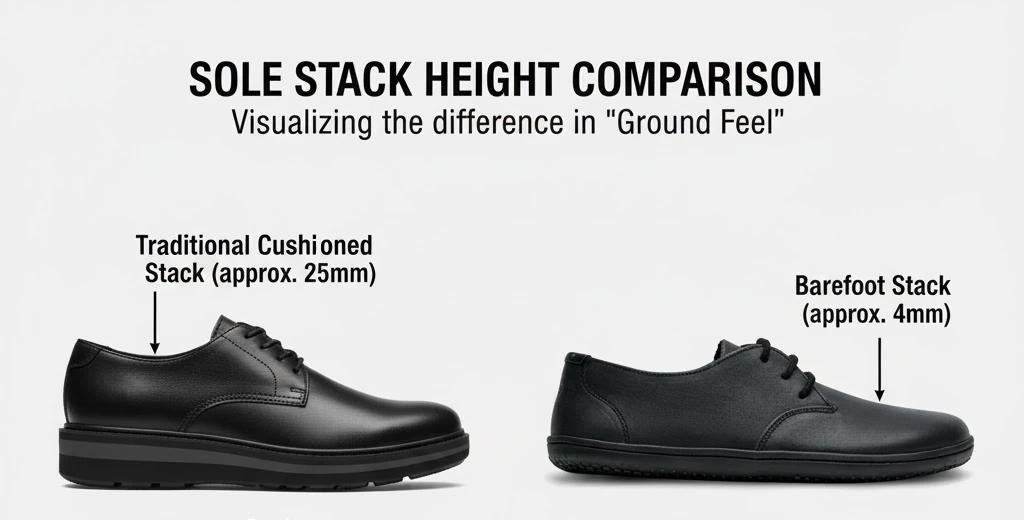
Forget the marketing. These factors actually matter when you’re on your feet all day.
Ground Feel vs Impact Protection
Barefoot shoes use thin soles (4-10 mm). Your feet do the work instead of foam. This strengthens them over time, but there’s a trade-off.
Hard hospital tile or warehouse concrete feels different than cushioned running shoes. Some models add a removable insole for those first weeks.
Slip Resistance Matters More Than You Think
Wet hospital corridors. Greasy kitchens. Spilled drinks on retail floors.
If you work around liquids, you need actual slip resistance, not just good tread. The Xero Prio All-Day SR is built for this. Regular Prios aren’t close on wet tile.
Professional Appearance Requirements
Some workplaces demand closed-toe, all-black, leather-look shoes. Others don’t care.
A nurse can’t wear bright trainers. A developer at a standing desk can wear whatever. Match your environment. The Vivobarefoot Ra IV and Xero Dillon work in offices. The HFS II looks too sporty for most professional settings.
Durability for Daily Miles

You’re walking 6-10 miles per shift, five days a week. That’s 1,500-2,500 miles per year.
Cheap shoes disintegrate. Even quality barefoot shoes wear differently depending on sole compound and your gait. Xero’s 5,000-mile sole warranty matters here.
7 Best Barefoot Shoes for Standing All Day
Organized by use case, not arbitrary rankings. Find your situation below.
TL;DR? Check the comparison table below for a quick overview, then read the detailed breakdowns for the shoes that match your needs.
At-a-Glance Comparison
| Model | Price | Slip-Resistant | Stack Height | Best For | Shop |
|---|---|---|---|---|---|
| Freet Mooch | £37.50 | No | 9.5 mm | Budget / Beginners | View Price → |
| Xero Prio SR ⭐ | £95-110 | Yes | ~7.5 mm | Nurses / Healthcare / Food Service | View Price → |
| Vivobarefoot Ra IV | £130-150 | No | ~6 mm | Business Formal / Corporate | View Price → |
| Xero Dillon | £90-100 | No | ~8.5 mm | Slip-On / Business Casual | View Price → |
| Vivobarefoot Primus Lite III | £120-140 | No | ~3 mm | UK Buyers / Premium Quality | View Price → |
| Xero HFS II | £100-120 | No | 5.5 mm | Maximum Ground Feel | View Price → |
| Xero 360 | £110-130 | No | ~9.5 mm | Transition / Active Standing | View Price → |
| Xero Glenn | £110-140 | No | ~7 mm | Dress-Casual / All-Day Office | View Price → |
| Xero Phoenix Knit (Women) | £70-90 | No | ~7.5 mm | Dress Flat / Client-Facing | View Price → |
| Groundies Milano | €120-150 | No | ~6.3 mm | Business / Extra Toe Space | View Price → |
| Vivobarefoot Sensus Moc (Leather) | £135-150 | No | 3 mm (no insole) | Business-casual / Adapted feet | View Price → |
← Swipe table to see all columns →
⭐ = Top pick for most people | Stack height includes removable insoles where applicable

Find Your Perfect Shoe by Job Type
Match your actual work environment to the right shoe, no guesswork needed
Healthcare Workers (Nurses, Doctors, Techs)
Corporate Office / Business Formal
Retail / Warehouse / Food Service
Standing Desk / Tech / Creative
Fitness Trainers / Gym Staff / Active Roles
Still not sure? Default to the Xero Prio All-Day SR (£95-110). It handles 80% of standing jobs brilliantly.
Detailed Reviews
Want the full story? Here’s what I learned testing each shoe.
Budget Pick
1. Freet Mooch (£37.50)
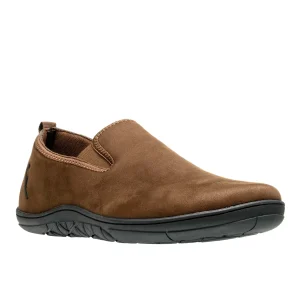
Best for: Beginners | All-day standing | Office workers | Anyone wanting slip-on convenience
At £37.50, the Freet Mooch solves the beginner problem. Enough cushioning (6.5 mm sole + 3 mm removable insole = 9.5 mm total stack) to prevent pain, zero-drop for natural gait, and slip-on design.
Tested on 10-12 hour shifts on hard floors. Your feet shouldn’t hurt.
The removable 3 mm insole gives you options. More cushioning early on, true barefoot feel later.
After 300+ miles of testing, the stitched-and-glued sole shows no separation. The wide toe box is genuinely wide, your toes can spread.
What doesn’t work: Heavy rain (soaks through in 10 minutes), running (slip-on doesn’t lock your foot), hot weather over 25°C.
For standing all day indoors? Excellent.
Get the Freet Mooch (Use code BARETREAD10 for 10% off) | Read our full Mooch review →
For Nurses & Healthcare Workers

2. Xero Prio All-Day SR (Slip-Resistant)
Best for: Nurses | Doctors | Food service | Any wet environment
This is the one.
Specific rubber compound for slip resistance on wet floors. 5.5 mm FeelTrue sole + removable 2 mm insole (7.5 mm total stack, pull the insole out after two weeks as your feet strengthen). Tested on soapy hospital linoleum and restaurant tile. It grips.
The regular Prio has better ground feel, but this has the traction you need.
The mesh upper breathes, the toe box gives your toes room to splay, and it comes in all-black for dress codes. Weight: 7.4 oz.
Downsides: Not pretty, and the mesh won’t love harsh chemicals.
Get the Prio All-Day SR from Xero | Read our full Prio review →
3. Xero HFS II
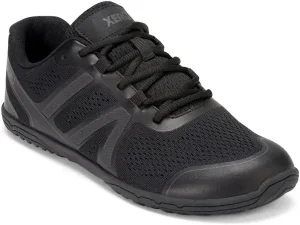
Best for: Maximum ground feel | Active workers | Non-slippery environments
The Highly Flexible Shoe.
If the Prio is a workhorse, the HFS II is a precision instrument. 5.5 mm FeelTrue sole with excellent ground feel. You’ll notice texture changes across different flooring. This builds foot strength quickly.
The trade-off? Less cushioning than models with thicker insoles. Your feet will feel more tired in the first weeks.
After adaptation, many report less fatigue at hour 10 than they had at hour 6 in cushioned shoes. The huarache-style lacing dials in fit.
Not for slippery environments. The sole excels on dry surfaces but lacks the SR compound. The sporty look won’t pass strict dress codes.
Check HFS II on Xero Shoes | Read our full HFS review →
Office & Professional Settings
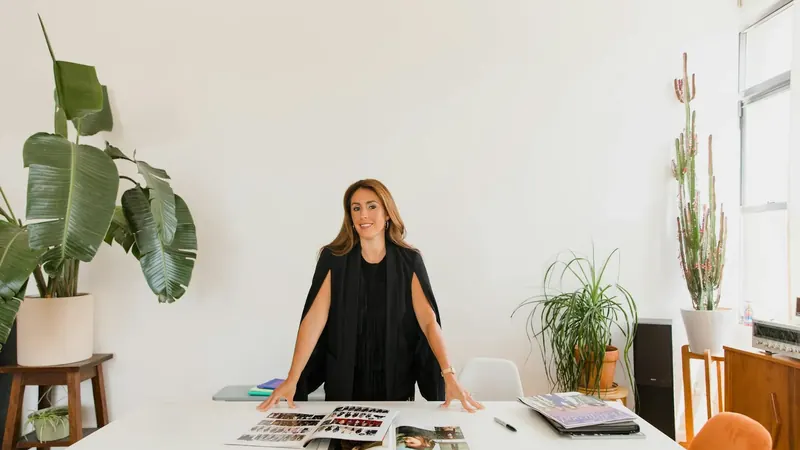
4. Vivobarefoot Ra IV
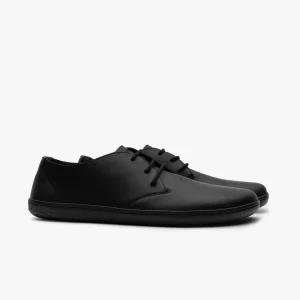
Best for: Corporate offices | Business formal | Standing desks | Client-facing roles
Leather Oxford on Vivo’s thin, flexible platform (3 mm outsole + removable insole = ~6 mm total stack). Dress-code friendly shape with a roomy forefoot and zero drop. The insole gives new wearers a softer start on hard floors; pull it later for more feel.
Limitations: Not slip-rated. Leather needs occasional care.
Want maximum ground feel and your office allows a moc-toe? See the Sensus Moc below.
View Ra IV at Vivobarefoot | Read our Ra III review →
Alternative: Vivobarefoot Sensus Moc (Leather)
Moc-toe look, ultra-thin 3 mm Sensus outsole, no insole . Amazing feel once adapted, harsher for beginners on long tile shifts.
Check Sensus Moc at Vivobarefoot
5. Xero Dillon
Best for: Slip-on convenience | Business casual | Standing desks | Light duty retail
Simple slip-on with elastic gore panels. Clean canvas upper that suits most offices. Available in all-black for stricter dress codes.
Why it works for standing all day: 6 mm sole + removable 2.5 mm insole = 8.5 mm total stack, so you get barefoot benefits without a harsh start. The heel counter is firm enough to stay on while walking yet flexible at the ankle.
Limitations: Less adjustability than laced shoes. Not waterproof.
Shop Xero Dillon | Read our full Dillon review →
6. Vivobarefoot Primus Lite III
Best for: UK buyers | Premium build quality | Active professionals | Style-conscious workers
Vivo’s flagship minimalist trainer with 3 mm PRO5 puncture-resistant outsole (no insole by default). Premium materials, excellent QC, and looks good enough for after-work plans. The PRO5 layer protects without bulk. The recycled polyester upper breathes well, which matters on long days.
Downsides: Expensive. Not slip-resistant for wet environments. Sizing runs large for many.
UK logistics and 100-day trial are strong conveniences.
Check Primus Lite III at Vivobarefoot
7. Xero 360
Best for: Coming from cushioned shoes | Cross-training | Warehouse work | Active standing
The 360 has the most stack here at about 9.5 mm total (6 mm sole + 3.5 mm removable insole). Still zero-drop but with enough cushioning to make transition gentle.
Great for people who stand and move a lot. The wider base adds stability for lateral moves. Tension straps help customize midfoot fit, which matters when feet swell during long shifts.
Not as much ground feel as HFS II or Prio. Chunkier design won’t work in formal offices.
See Xero 360 | Read our full 360 review →
Price vs Performance: What You’re Actually Paying For
Higher price = better durability and materials, not necessarily more comfort
Trade-offs: Less durable than premium (6-8 months heavy use), basic styling, not waterproof.
Best for: Beginners, light duty, dry indoor environments.
Trade-offs: Not premium leather, some models need break-in period.
Best for: Daily workers, nurses, retail staff, most standing jobs.
Trade-offs: Higher cost doesn’t mean more comfort, just better materials and longevity.
Best for: Business formal, brand-conscious buyers, those wanting maximum longevity.
Reality check: The £95 Xero Prio SR performs identically to the £140 Vivobarefoot on 12-hour shifts. You’re paying extra for materials/aesthetics, not comfort. Choose based on your actual needs, not price tags.
Common Questions From People Actually Standing All Day
The first two weeks can be uncomfortable as your feet wake up unused muscles. Thin soles don’t mean pain, they allow natural impact absorption through proper mechanics instead of foam. Most people report less foot pain after adaptation, even on concrete. Start with models that have removable insoles (Prio, 360) and remove them gradually.
Only the Xero Prio All-Day SR has a purpose-built slip-resistant outsole. The regular Prio, HFS, and others have decent traction on dry floors but aren’t rated for wet environments. Don’t gamble with cheap listings if you work around liquids, the Prio SR exists specifically for this use case.
Don’t go straight to full shifts. Wear them 2-3 hours in week one, 4-5 hours in week two, and build to full shifts over 4-6 weeks. Soreness is normal. Sharp pain means stop. If you must be in shoes all day for work, alternate between barefoot shoes and your old shoes during the transition. Read our full transition guide for more details.
Thin socks work best. Thick cushioned socks defeat the purpose and make the toe box cramped. Merino wool is ideal because it wicks moisture on 12-hour shifts and smells less than synthetics. Some wear toe socks (Injinji) to prevent blisters during adaptation.
Xero Shoes often last 1,000-2,000 miles and have a 5,000-mile sole warranty. Vivobarefoot is similar depending on model. If you walk 6-8 miles per shift, that’s 30-40 miles per week. Expect 6-12 months per pair with heavy use.
Rotating two pairs extends lifespan significantly. Shoes need 24-48 hours to dry fully and rebound between wears. Many start with one pair and add a second later. Air them out between shifts because mesh and canvas can get funky.
Making Your Decision: What Actually Works
After testing these shoes across different work environments and shift lengths, here’s the verdict.
The Xero Prio All-Day SR is the default choice for anyone working around wet floors. It’s not pretty or flashy, but it works.
For office workers and standing desk people, the Vivobarefoot Ra IV looks properly professional while the Dillon offers slip-on convenience. Want maximum ground feel and don’t care about appearance? The HFS II is hard to beat.
Budget shoppers: Start with the Freet Mooch (£37.50) and upgrade to Xero when you’re convinced. UK buyers: Vivobarefoot has easier shipping and returns.
Stop overthinking it. Pick the shoe that matches your environment, order your normal size (or check our Xero sizing guide), and commit to the adaptation period.
Your feet may hurt for two weeks. Then they’ll feel better than they have in years.
Ready to Give Your Feet What They Actually Need?
Stop fighting your feet with supportive shoes that make them weaker. Try barefoot shoes designed for people who stand all day.
Related Articles You Might Find Helpful
- Best Xero Shoes for Nurses — Specific recommendations for healthcare professionals
- Best Barefoot Dress Shoes — Professional options for the office
- How to Transition to Barefoot Shoes — Essential guide for beginners
- Xero Shoes Sizing Guide — Get the perfect fit
- Best Vivobarefoot Alternatives — Compare other brands
This article contains affiliate links. If you purchase through our links, we may earn a small commission at no extra cost to you. This helps us keep testing shoes and writing honest reviews.






